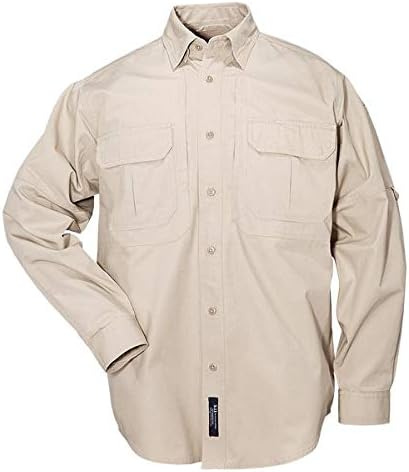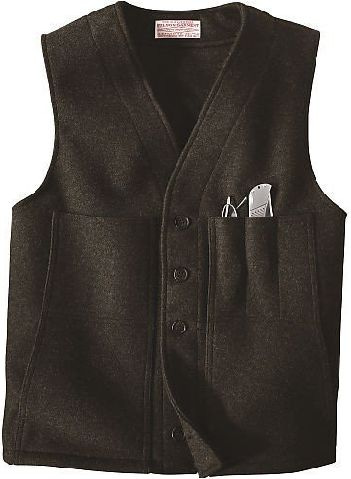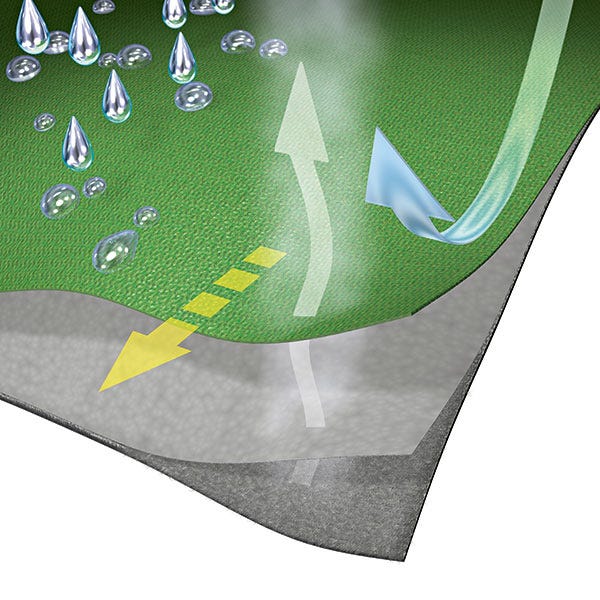Cop shirts
I have five now and plan to get more. The 5.11 does everything I want in terms of comfort and pockets and yet looks dignified enough to serve as duty shirts for police, who are its primary market.
The 5.11 Tactical shirt is based on Royal Robbins’ excellent Expedition Shirt (which I’ve praised elsewhere in Cool Tools); the main difference is that it’s 100% cotton. The most appealing functional features for me are: 1) large document pockets hidden on each side of the shirt front (my cell phone/PDA lives in one, my Levenger notepad in the other); 2) a subtle vent on the back, with non-cotton wicking lining for the back and shoulders (which makes it a four-season shirt, good with or without a T-shirt underneath); and 3) the best keepers for rolled shirtsleeves (also a help for four-season use or variable weather).
Appearance features: 1) nifty upper-sleeve pen pocket, an improvement on noising up your chest with metal in a breast pocket; 2) shirt buttons that are colored to blend in with the fabric color, so you’re not a row of dots; 3) velcro pocket closures, less conspicuous and handier than buttons; 4) sensible colors. There are optional features of interest to cops but not to me—hidden button-down for collar, sew-on epaulets, sew-on badge holder.
The shirt is available for women as well as men. Also comes in a short-sleeve version. Colors are white, sage, khaki, olive green, charcoal, navy blue, and black; I most like the green and black. (There is a variation of the 5.11 shirt called “A/B” which I suggest avoiding. It’s too coppy—sewn-in pleats, epaulets, and badge-holder, and an unpleasant synthetic material emphasizing rayon. Get the cotton.) — Stewart Brand
The 5.11 tactical shirt is simply the best field/hiking shirt I have owned. If you are the kind of person who juggles maps and notebooks while outdoors, this is the only shirt to wear. At first glance, it looks like a typical hiking shirt, but the difference is in the details.
For example, the “Napolean” pockets ( large horizontal velcro-closed slash pockets behind the visible breast pockets) are huge –7-inches by 8-inches. Large enough to comfortably hold a folded topo map and notepad in the field or a wallet and and a PDA in town. The pockets were originally designed to hold pistols for cops, so one can comfortably carry heavy objects in them. Other details include pen slots on the left pocket and the upper left sleeve. The right pocket has a hidden zipper to securely store small items, and the sleeves have the first practical roll-up keepers I have found.
This is a truly versatile shirt, that fits in anywhere from the Sierra to casual business meetings. I was grateful to have all those pockets recently while standing on a wilderness ridge in a driving rain at midnight, juggling a radio and map and scribbling on a rite-in-the-rain pad. But I also wear my navy blue version of the shirt (I own five) as my standard casual business dress. It goes nicely with khaki dockers and lets me carry my wallet and other junk without resort to the usual pants-pocket bulge. — Paul Saffo
Utilitarian daily-wear vest
My Filson Mackinaw Vest is the single most utilitarian piece of clothing I own. And during the fall, winter, and early spring I wear it nearly every day. We’ve reviewed Filson in the past. They have a legendary reputation among hunters and outdoorsman for wool clothing that stays warm when wet, and holds up over time. This holds true for this vest, but I love it because it’s just as functional at home or in an office as it is in the field.
It also features two chest pockets; the right easily fits a notepad, while the left is designed for holding writing instruments, or other tools (I keep a Maratac AAA flashlight, and a few pens and pencils).
Most vests are NOT built for daily wear. Stitching comes undone, fabric begins to tear or pill, and in general they become limp and lifeless after just a few months. The beauty of the Filson is that its heavyweight felted wool and heavy-duty stitching make it near bulletproof. It doesn’t shed, pill, or wrinkle, and it looks good day in and day out. And because it’s a vest made of thick felted wool it can be worn over three seasons and across a really wide temperature range. — Oliver Hulland
Ultralight windbreaker
When folded into its stuff sack, this Pertex windshirt is the size of a small apple and weighs only about 100g. Unlike a “real” coat, the smock can disappear into a jacket pocket or cargo pocket of your combat pants or it can lurk, weightlessly, for weeks in a backpack until needed. Other than being a carry-all-the-time item allowing minimal bulk, it’s extremely versatile. It blocks the wind, preventing windchill, while still feeling as breathable as a lightweight cotton t-shirt. Pull up the neck zip and the smock will trap a layer of air around your body. Because the smock keeps this air dry instead of letting it saturate with sweat, it’s a superb insulator: the ground outside has been white with frost recently, but I’ve been quite happy walking around with the smock over my sweater (about 0 Centigrade). Shower resistant, but not waterproof, it’s much more breathable than anything I’ve tried that is waterproof — while Goretex may transmit about 25% of water vapour in even ideal circumstances, Pertex scores closer to 100%. As such, the windshirt is a great outer layer for hikers, cyclists and runners to wear in all conditions where real rain wear isn’t essential. It’s also terrific for commuting and tourism, especially when added to a light umbrella, which allows you to leave heavier-to-carry and sweatier-to-wear just-in-case clothes at home. — Jonathan Coupe
Maximum movement with maximum comfort
My latest revelation in gear: all the new outdoor clothes I really like share this common thread, that they are made of hi-tech softshell fabrics produced by the same Swiss company, Schoeller. Softshell outdoor clothes are more than just stretchy. They mark a better way of constructing the clothes that you wear while exerting energy. Essentially the Schoeller fabrics are similar to GoreTex but they are more permeable and they stretch. This allows much more free motion, more breathability, and allows the clothes to fit tighter saving material weight.
Softshells shed moister/heat/sweat *much* faster than GoreTex and they are super comfy at the end of the day around camp or even in your sleeping bag. However my favorite characteristic of these new fabrics is that they act similar to fleece so that they keep their ability to insulate and feel good against the skin even if they are saturated with water, whereas hardshell fabrics just feel like wet plastic bag against your body. These Schoeller fabrics are super good for cycling, climbing, and mountaineering… basically sports where you sweat. I still like hardshell garments for sailing and snowboarding where for the most part you are being eaten by the wind and weather.
The best softshell clothing companies I have found:
Cloudveil: Excellent pants and tops
Arcteryx: Bad web site, amazing gear all around. They also have hybrid soft/hardshell clothes that I have yet to try but look very promising.
Beyond Fleece: Allows you to customize the gear you order. Add pockets, hoods, waterproof zippers etc…
Much of this gear is prohibitively expensive, like $300 for a jacket. I usually go to local dealers and figure out the sizing and then shop around on the outlets. — Alexander Rose






